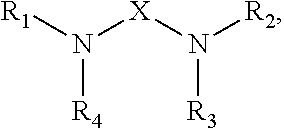Amidoamine and polyamide curing agents, compositions, and methods
a technology of amidoamine and polyamide, applied in the preparation of amino compounds, organic chemistry, carboxylic acid amides, etc., can solve the problems of increasing relative prices of teta and tepa, and achieve the effects of good coating appearance, fast drying speed, and good coating appearan
- Summary
- Abstract
- Description
- Claims
- Application Information
AI Technical Summary
Benefits of technology
Problems solved by technology
Method used
Image
Examples
synthesis examples
[0082]Viscosity was measured by a Brookefield viscometer, amine value was determined by a Metrohm titrator, and chemical composition of the amidoamine and polyamides was analyzed by nuclear magnetic resonance (NMR). The NMR experiments were performed at ambient temperature employing the Bruker DRX-400 FT-NMR spectrometer equipped with a 10 mm BBO probe. Quantitative 13C NMR data was acquired using inverse-gated decoupling, a 45° pulse, and a 6 second relaxation delay. The samples were dissolved in chloroform-d with chromium acetylacetonate added as a relaxation agent. The chemical shift scale was referenced to the solvent peak. The composition of the multifunctional amine represented by Structure (I) was analyzed by gas chromatograph (GC). The amount of unreacted multifunction amine of Structure (I) in amidoamines and polyamides was analyzed by GC as well.
example 1
of Multifunctional Amine Represented by Structure (I)
[0083]Step 1. Cyanoethylation of Diethylenetriamine
[0084]A 2-gallon Parr reactor was charged with 2,491 g diethylenetriamine (24.2 moles) then sealed. The agitator was started, and the reactor was purged with nitrogen then heated to 70 degrees Celsius. When the temperature was at 70 degrees Celsius, 2,689 g acrylonitrile (50.7 moles) was charged from an Isco pump over 2 hours. The reaction mixture was stirred for 30 minutes at 70 degrees Celsius after the addition was completed. The product then was cooled to ambient temperature and discharged from the reactor into a bottle. Analysis of a sample by GC showed that the mixture contained 0.9% acrylonitrile, 7.8% monocyanoethylated diethylenetriamine, 65.8% dicyanoethylated diethylenetriamine (mixture of isomers), and 23.8% tricyanoethylated diethylenetriamine (mixture of isomers).
[0085]Step 2: Semi-Batch Hydrogenation of Cyanoethylated Diethylenetriamine of Step 1
[0086]A 2-gallon Par...
example 2
of Amidoamine from Example 1
[0087]A one-liter glass reactor was equipped with an overhead stirrer, a nitrogen inlet, a distillation head with a 50 mL of graduated receiver. To the glass reactor was added 220.1 g of TOFA (Sylfat FA-1, Arizona Chemical Co.) while purging the system slowly with nitrogen. The stirrer was started after the addition of TOFA. To the reactor was then added 175.5 g of the multifunctional amine of structure (I) from Example 1 over ten minutes and the stirrer rate was increased to 350 rpm. The contents were then heated to 265 degrees Celsius and 17.5 g of distillate was removed by distillation. During the first phase of the reaction, distillate was removed by atmosphere distillation, and vacuum was applied during the second phase of the reaction. After the desired amount of distillate was collected, the reactor was cooled to 65 degrees Celsius and the content was discharged. The final product had an amine value of 438 mg KOH / g, a viscosity of 491 centipoises, ...
PUM
| Property | Measurement | Unit |
|---|---|---|
| wt % | aaaaa | aaaaa |
| temperature | aaaaa | aaaaa |
| temperature | aaaaa | aaaaa |
Abstract
Description
Claims
Application Information
 Login to View More
Login to View More - R&D
- Intellectual Property
- Life Sciences
- Materials
- Tech Scout
- Unparalleled Data Quality
- Higher Quality Content
- 60% Fewer Hallucinations
Browse by: Latest US Patents, China's latest patents, Technical Efficacy Thesaurus, Application Domain, Technology Topic, Popular Technical Reports.
© 2025 PatSnap. All rights reserved.Legal|Privacy policy|Modern Slavery Act Transparency Statement|Sitemap|About US| Contact US: help@patsnap.com



